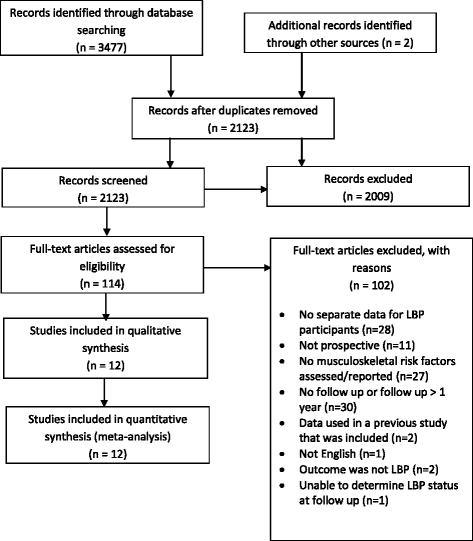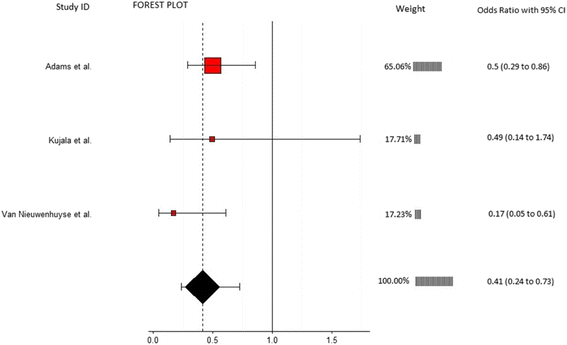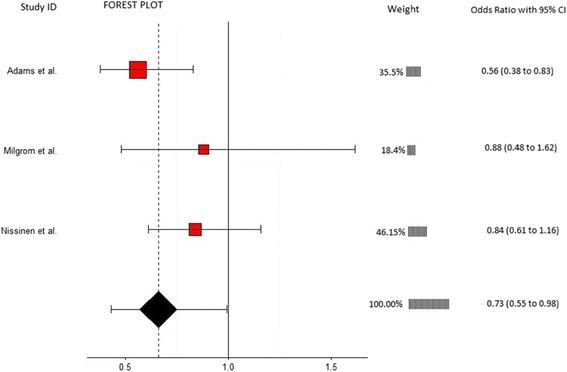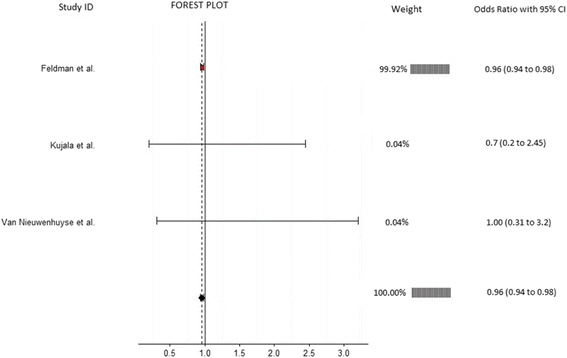Restriction in lateral bending range of motion, lumbar lordosis, and hamstring flexibility predicts the development of low back pain: a systematic review of prospective cohort studies - PubMed (original) (raw)
Review
Restriction in lateral bending range of motion, lumbar lordosis, and hamstring flexibility predicts the development of low back pain: a systematic review of prospective cohort studies
Sean G Sadler et al. BMC Musculoskelet Disord. 2017.
Abstract
Background: Low back pain (LBP) is an increasingly common condition worldwide with significant costs associated with its management. Identification of musculoskeletal risk factors that can be treated clinically before the development of LBP could reduce costs and improve the quality of life of individuals. Therefore the aim was to systematically review prospective cohort studies investigating lower back and / or lower limb musculoskeletal risk factors in the development of LBP.
Methods: MEDLINE, EMBASE, AMED, CINAHL, SPORTDiscus, and the Cochrane Library were searched from inception to February 2016. No age, gender or occupational restrictions of participants were applied. Articles had to be published in English and have a 12 month follow-up period. Musculoskeletal risk factors were defined as any osseous, ligamentous, or muscular structure that was quantifiably measured at baseline. Studies were excluded if participants were pregnant, diagnosed with cancer, or had previous low back surgery. Two authors independently reviewed and selected relevant articles. Methodological quality was evaluated independently by two reviewers using a generic tool for observational studies.
Results: Twelve articles which evaluated musculoskeletal risk factors for the development of low back pain in 5459 participants were included. Individual meta-analyses were conducted based on risk factors common between studies. Meta-analysis revealed that reduced lateral flexion range of motion (OR = 0.41, 95% CI 0.24-0.73, p = 0.002), limited lumbar lordosis (OR = 0.73, 95% CI 0.55-0.98, p = 0.034), and restricted hamstring range of motion (OR = 0.96, 95% CI 0.94-0.98, p = 0.001) were significantly associated with the development of low back pain. Meta-analyses on lumbar extension range of motion, quadriceps flexibility, fingertip to floor distance, lumbar flexion range of motion, back muscle strength, back muscle endurance, abdominal strength, erector spinae cross sectional area, and quadratus lumborum cross sectional area showed non-significant results.
Conclusion: In summary, we found that a restriction in lateral flexion and hamstring range of motion as well as limited lumbar lordosis were associated with an increased risk of developing LBP. Future research should aim to measure additional lower limb musculoskeletal risk factors, have follow up periods of 6-12 months, adopt a standardised definition of LBP, and only include participants who have no history of LBP.
Keywords: Low back pain; Meta-analysis; Prospective cohort studies; Risk factors; Systematic review.
Figures
Fig. 1
PRISMA flow diagram
Fig. 2
Annotated forest plot for lateral flexion range of motion and LBP
Fig. 3
Annotated forest plot for lumbar lordosis and LBP
Fig. 4
Annotated forest plot for hamstring flexibility and LBP
Similar articles
- Comparisons of hamstring flexibility between individuals with and without low back pain: systematic review with meta-analysis.
Hori M, Hasegawa H, Takasaki H. Hori M, et al. Physiother Theory Pract. 2021 May;37(5):559-582. doi: 10.1080/09593985.2019.1639868. Epub 2019 Jul 18. Physiother Theory Pract. 2021. PMID: 31317831 - Structural Changes of Lumbar Muscles in Non-specific Low Back Pain: A Systematic Review.
Goubert D, Oosterwijck JV, Meeus M, Danneels L. Goubert D, et al. Pain Physician. 2016 Sep-Oct;19(7):E985-E1000. Pain Physician. 2016. PMID: 27676689 Review. - Comparing lumbo-pelvic kinematics in people with and without back pain: a systematic review and meta-analysis.
Laird RA, Gilbert J, Kent P, Keating JL. Laird RA, et al. BMC Musculoskelet Disord. 2014 Jul 10;15:229. doi: 10.1186/1471-2474-15-229. BMC Musculoskelet Disord. 2014. PMID: 25012528 Free PMC article. Review.
Cited by
- The Additional Effect of Neurodynamic Slump and Suboccipital Muscle Inhibition to Passive Stretching of the Short Hamstring: A Single-Blind, Randomized Controlled Trial.
Eladl HM, Ali OI, Abdelraouf OR, Ibrahim ZM, Bin Sheeha B, Alabas AM, Alzare SH, Amin WM. Eladl HM, et al. Healthcare (Basel). 2024 Oct 29;12(21):2152. doi: 10.3390/healthcare12212152. Healthcare (Basel). 2024. PMID: 39517364 Free PMC article. - Comparison of Clinical Characteristics between Responders and Non-Responders to Hamstring Stretching in Individuals with Chronic Low Back Pain.
Dobija L, Pereira B, Dupeyron A, Coudeyre E. Dobija L, et al. Diagnostics (Basel). 2024 Sep 24;14(19):2117. doi: 10.3390/diagnostics14192117. Diagnostics (Basel). 2024. PMID: 39410521 Free PMC article. - Association between lower limb alignment and low back pain: A systematic review with meta-analysis.
Abbasi S, Mousavi SH, Khorramroo F. Abbasi S, et al. PLoS One. 2024 Oct 10;19(10):e0311480. doi: 10.1371/journal.pone.0311480. eCollection 2024. PLoS One. 2024. PMID: 39388409 Free PMC article. - Association of Physical Performance with Mental and Physical Health-Related Quality of Life and Low Back Pain-Related Disabilities among Older Adults with Severe Obesity.
Bayartai ME, Tringali G, De Micheli R, Danielewicz AL, Sartorio A. Bayartai ME, et al. J Clin Med. 2024 Sep 22;13(18):5614. doi: 10.3390/jcm13185614. J Clin Med. 2024. PMID: 39337101 Free PMC article. - A Randomized Controlled Trial of Active Stretching of the Hamstrings and Core Control for Low Back Pain and Musculoskeletal Discomfort during Prolonged Sitting among Young People.
Plandowska M, Labecka MK, Truszczyńska-Baszak A, Rajabi R, Płaszewski M. Plandowska M, et al. J Clin Med. 2024 Aug 26;13(17):5048. doi: 10.3390/jcm13175048. J Clin Med. 2024. PMID: 39274261 Free PMC article.
References
- Vos T, Barber RM, Bell B, Bertozzi-Villa A, Biryukov S, Bolliger I, Charlson F, Davis A, Degenhardt L, Dicker D, et al. Global, regional, and national incidence, prevalence, and years lived with disability for 301 acute and chronic diseases and injuries in 188 countries, 1990-2013, a systematic analysis for the Global Burden of Disease Study 2013. Lancet. 2013;386(9995):743–800. doi: 10.1016/S0140-6736(15)60692-4. - DOI - PMC - PubMed
- Airaksinen O, Brox JI, Cedraschi C, Hildebrandt J, Klaber-Moffett J, Kovacs F, Mannion AF, Reis S, Staal JB, Ursin H, et al. Chapter 4. European guidelines for the management of chronic nonspecific low back pain. Eur Spine J. 2006;15(Suppl 2):192–300. doi: 10.1007/s00586-006-1072-1. - DOI - PMC - PubMed
Publication types
MeSH terms
LinkOut - more resources
Full Text Sources
Other Literature Sources
Miscellaneous



